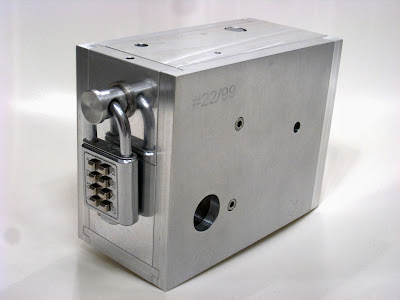Update 23 October 2017 - Dear Reader, please check out my new puzzle blog and e-store at http://mechanical-puzzles.com
Name
Angel Box
Designer
Wil Strijbos. For a list of Wil's puzzle designs, click here.
 |
| Angel peeking out of the window |
Wil Strijbos. As far as I am aware, still available in a limited edition series of 99 units at 390 Euros each (excl S&H). Please PM me via my Profile email if you wish to contact Wil to buy one.
Sequential Discovery.
15.8 cm (Length) x 7 cm (Width) and 11 cm (Height)
Materials & Construction
Aluminium, steel, plastic and acrylic. The entire puzzle box is made out of polished aluminium and inside there are some other bits and parts made from plastic, steel and acrylic
This is a behemoth of a puzzle weighing more than 2kg. Quality of construction, fit and finish is excellent. The individual parts and pieces are all CNC machined to very high standards and exact tolerances.
 |
This is Wil Strijbos' third sequential discovery puzzle, after the First Box and Lotus, both reviewed earlier in this blog. It is also his most ambitious puzzle to-date; far surpassing the First Box and Lotus both in terms of physical complexity and level of difficulty. For those not familiar, a "sequential discovery" puzzle is one where you execute a series of steps in a particular order with the aid of "tools" found within the puzzle in order to solve the puzzle. No external tools are needed (or permitted).
There is some history of how Wil came to design the Angel Box and this usually accompanies the puzzle's instructions on what to do (and not to do) while solving the Angel Box. A couple of the earliest puzzle solvers had used unauthorised tools, although these did come with the puzzle! After some clarification from Wil, all was understood.
The object of the Angel Box is to free the cute little Angel inside the box. And to do so, one must first open up the box. As you can tell from the photo above, the Box is a rather industrial looking rectangular metal object secured by a combination padlock. The beginning step is to unlock the padlock. The padlock comes with a number code plate, but Wil will have swapped your code plate with someone else's so the code you have doesn't work for your padlock; its there only for show.
You may not believe this, but unlocking the padlock is actually the easiest step in the entire solving process! No worries, its quite doable; you do not need any lock-picking or locksmith skills.
After the padlock is removed, the sequential discovery part(s) come into play. The next step requires you to search for tools hidden within the box which you will need to proceed. And upon finding the tool(s), the rest of the (very challenging) puzzling journey continues to figure out how to take apart the box.
Based on my own personal count, there are a total of 25 steps/moves (excluding any trial and error, assuming every step/move is correct) broadly covering three groups of tasks/challenges before arriving at the angel. And this is only AFTER the padlock has been removed, which itself is a puzzle! Not quite a simple affair of opening a lid or two; you literally need to dissect the box to solve this one.
The Angel Box truly epitomises what is a really good sequential discovery puzzle. There are many steps to "conquer" and some are more difficult than others but as you successfully solve each step along the way, you are rewarded with a "a-ha" moment. Because of this, the Angel Box is one of those puzzles that will allow you to feel satisfied just solving one part at a time; to put it away and continue the next day. "No rush, just enjoy", as Wil mentioned in his email to me. However, impatient as I usually am, I went non-stop and solved the box in a single sitting, in just under two hours. I was very impressed with the insides of the box; quite a mechanical marvel in terms of the design and manufacture.
Freeing the Angel is not the final step...there is one last challenge still...but I will leave it to Angel Box owners to discover this for themselves without saying more.
Just as there are many challenging steps, there are just as many if not more, bits and pieces one would accumulate (some very small) as the solving progresses. Owners of the Angel Box would do well to be careful when handling these small items. Losing the most critical parts within the puzzle (which is very possible in this case if one is careless) would mean getting stuck indefinitely until (external) help arrives!
Difficulty Rating
Very challenging at every stage but not a puzzle that you will frustrate you out of your wits. As I have mentioned, the interim successes you find along the way as you go through the solving journey will keep you confident and motivated to the end.
Summary
A very expensive puzzle no doubt, but the quality of the Angel Box and the puzzling experience makes it a worthwhile purchase. And with a limited production of just 99 units, definitely a collector's item. Get one before they run out!













